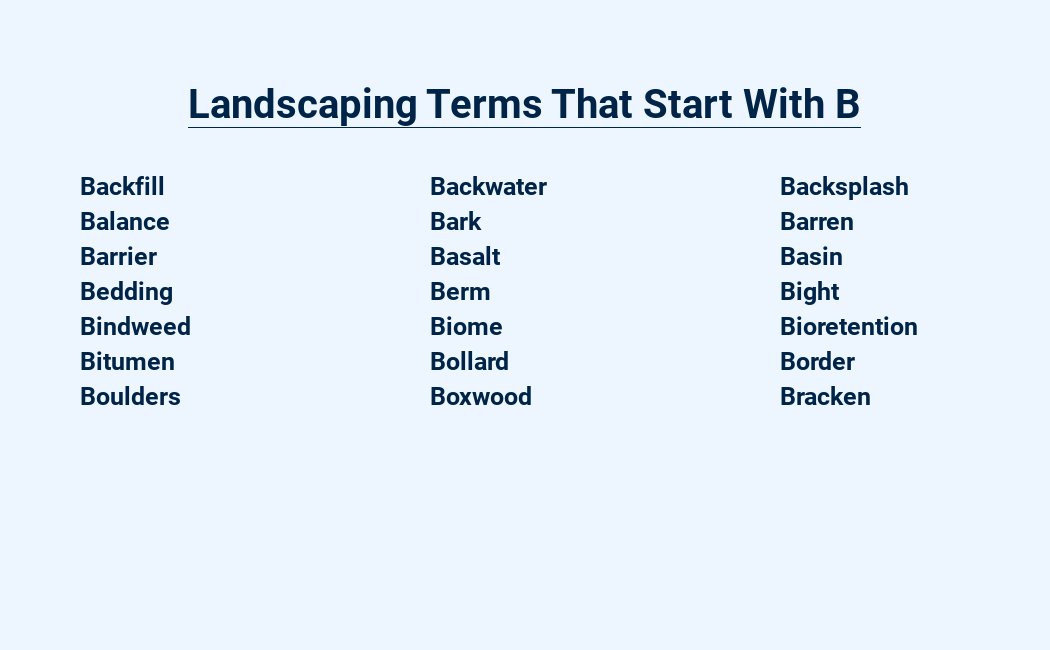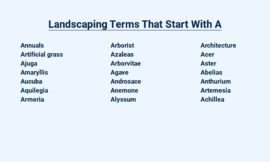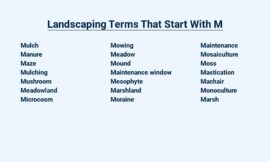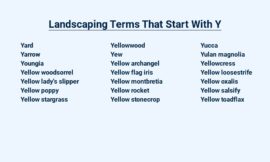Discover the world of landscaping with our comprehensive guide to terms starting with the letter “B”. From the basics of backfill and balled and burlapped plants to the beauty of berms and bird baths, we’ll explore essential concepts and practical tips to enhance your outdoor spaces.
Delve into the fascinating realm of horticulture and transform your landscape into a haven of beauty and tranquility.
| Term | Description |
| Backfill | The process of filling in an excavated area with soil or other material. |
| Bedding | A layer of material, such as sand or gravel, that is placed beneath a patio, walkway, or other hardscape feature to provide drainage and support. |
| Berm | A mound of earth or other material that is constructed to block wind, water, or noise. |
| Blade | The cutting edge of a lawn mower or other landscaping tool. |
| Blower | A machine used to remove leaves and other debris from lawns and driveways. |
| Border | A strip of plants or other material that is used to define the edge of a bed or other garden feature. |
| Boxwood | A type of evergreen shrub that is often used in hedges and topiaries. |
| Bristlecone Pine | A type of pine tree that is known for its long lifespan and resistance to harsh conditions. |
| Bulbs | A type of plant that produces flowers from an underground storage organ. |
Backyard: The area of a property that is located behind the house, often used for outdoor activities and relaxation.
Bagworm: A type of moth larva that creates a protective case out of leaves and twigs, damaging plants by feeding on their foliage.
Bark: The outer layer of a woody plant’s stem, protecting the inner tissues from damage.
Bedding: A layer of plants, usually annuals, planted in a garden bed for colorful displays.
Bedrock: The solid rock layer beneath the soil, underlying the surface deposits and loose materials.
Berm: A mound of earth or other material constructed along a slope or edge to prevent erosion or serve as a visual barrier.
Bevel: A sloped edge or surface, typically created to provide a smooth transition between different materials or elements in a landscape design.
Biennial: A plant that completes its life cycle in two years, with vegetative growth in the first year and flowering and seed production in the second year.
Bindweed: A common weed with twining stems and trumpet-shaped flowers, known for its aggressive growth and ability to spread quickly.
Birch: A genus of deciduous trees and shrubs with smooth, white bark and catkins in the spring.
Bird bath: A shallow container filled with water, placed in a garden or yard to attract birds for drinking and bathing.
Birdhouse: A small structure, usually made of wood, designed to provide shelter and nesting sites for birds in a garden or natural area.
Black spot: A common fungal disease that affects roses, causing dark spots on the leaves and defoliation.
Blight: A plant disease caused by fungi, bacteria, or viruses, characterized by rapid wilting, discoloration, and death of plant tissues.
Block paving: A type of pavement made of interlocking concrete blocks, commonly used in patios, driveways, and walkways.
Bog garden: A specialized garden designed to mimic the conditions of a bog or wetland, often featuring water-loving plants and acidic soil.
Bonsai: The art of growing and training miniature trees and shrubs in containers, using techniques to control their size and shape.
Border: A strip of plants, often shrubs or perennials, used to define the edge of a garden bed or path.
Boxwood: A genus of evergreen shrubs known for their dense, compact growth habit and use in topiary and hedging.
Bromeliad: A group of tropical and subtropical plants, typically epiphytes, with colorful leaves and showy flowers, often grown in containers or conservatories.
Brown patch: A lawn disease caused by a soil-borne fungus, characterized by circular patches of brown, dead grass.
Brush pile: A collection of branches, twigs, and other woody debris gathered and piled up in a garden or natural area, providing habitat for wildlife and aiding in decomposition.
Budding: The process by which a new shoot or flower develops from a bud on a plant stem.
Bulb: A modified underground plant structure consisting of fleshy leaves that store food and energy, common in spring-blooming plants like tulips and daffodils.
Burlap: A coarse fabric made from jute or hemp fibers, often used for wrapping plants during transplanting or protecting them from frost.
Landscaping Terms Starting with B
Backfill
Backfill refers to the process of filling a hole or trench with soil, sand, or other material to restore the ground to its original level. It is commonly used in landscaping projects, construction, and utility installations to ensure proper drainage and support surrounding structures.
Balled and burlapped
Balled and burlapped refers to a method of preparing trees and shrubs for transplanting. The roots are wrapped in burlap and secured with twine, while the root ball is covered with soil and tied with twine.
This helps to keep the roots moist and protected during transport and planting.
Bare-root
Bare-root refers to plants that are sold without soil around their roots.
They are typically dormant and should be planted as soon as possible after purchase.
Bare-root plants are often less expensive than container-grown plants and can be easier to transport.
Basalt
Basalt, a dark, fine-grained igneous rock, is commonly used in landscaping for its durability and aesthetic appeal.
Its resistance to weathering and skid-resistant surface make it suitable for walkways, patios, and retaining walls, adding a natural and elegant touch to outdoor spaces.
Bedding plant
Bedding plants are decorative plants used to add color and interest to gardens and landscapes.
They are typically grown in containers or raised beds and can be easily transplanted.
Bedding plants include popular choices like petunias, marigolds, and zinnias.
Berm
A berm is a mound of earth or other material constructed as a barrier or landscaping feature.
Often used for erosion control, noise reduction, or visual screening, berms can also be planted with vegetation to enhance their aesthetic appeal.
Bindweed
Bindweed, a persistent perennial weed, is known for its aggressive growth and ability to quickly take over gardens and landscapes. Its extensive root system and ability to quickly spread make it a challenging weed to control.
Bindweed’s climbing stems and small, white flowers can also be unsightly and interfere with the growth of desired plants.
Bird bath
A bird bath is a shallow basin of water placed in a garden or other outdoor area to provide birds with a place to bathe and drink. Bird baths can be made from a variety of materials, including concrete, plastic, and metal.
Birdhouse
A birdhouse, also known as a nest box, is a small enclosure designed to provide shelter and nesting space for birds. These structures are typically made of wood or plastic and are placed in gardens, parks, and other outdoor areas to attract and support various bird species.
Black spot
Black spot is a fungal disease that commonly affects roses, causing dark spots on the leaves. It can lead to defoliation and weaken the plant.
Prevention includes avoiding overhead watering, removing infected leaves, and applying fungicides.
Blight
Blight, a detrimental affliction, can wreak havoc on plants, causing discoloration, wilting, and even death.
To prevent blight, gardeners must remain vigilant, employing preventive measures and prompt treatment when necessary to safeguard their precious flora.
Block paving
Block paving involves laying individual blocks or bricks in a specific pattern to create a durable and decorative surface for driveways, patios, and walkways.
The interlocking design provides stability and allows for various colors, textures, and patterns to enhance the aesthetic appeal of outdoor spaces.
Bog garden
A bog garden is a type of wetland garden featuring plants that thrive in moist, acidic soil.
It is often created in low-lying areas or near water sources.
Bog gardens provide a habitat for various wildlife and can be a beautiful addition to any landscape.
Bonsai
Bonsai, an ancient Japanese art form, involves cultivating miniature trees in containers. These artistically shaped trees mimic the grandeur of nature, promoting tranquility and harmony in limited spaces like gardens, patios, or even indoors.
Border
A border is a decorative or functional edge separating different areas of a landscape. Borders can be created using plants, rocks, mulch, or other materials.
They can add visual interest, define spaces, and control erosion.
Boxwood
Boxwood is a versatile evergreen shrub prized for its dense, compact growth habit and adaptability to various landscaping applications. Commonly used in formal gardens, hedges, and topiaries, Boxwood adds a touch of elegance and structure to any landscape design.
Bromeliad
Bromeliad, a genus of tropical plants, adds a touch of exotic beauty to any landscape. With their vibrant colors and unique shapes, these epiphytes thrive in warm climates, brightening gardens and patios alike.
Brown patch
Brown patch, a common lawn disease, causes unsightly brown circular patches in turfgrass. Caused by the fungus Rhizoctonia solani, it thrives in warm, humid conditions and can quickly spread, damaging the lawn’s overall health and appearance.
Brush pile
A brush pile is an accumulation of tree branches, limbs, and other woody debris, typically gathered for disposal or use as a habitat for wildlife.
Brush piles provide shelter, nesting sites, and food sources for a variety of animals, including birds, small mammals, and reptiles.
Budding
Budding, a vegetative propagation technique, involves removing a bud from a plant and grafting it onto another plant, allowing it to develop into a new shoot or plant. This technique is commonly used for fruit trees, roses, and ornamental plants to propagate desired traits and characteristics.
Bulb
A bulb is a modified, underground plant structure that serves as a storage organ for food and water. Bulbs are typically composed of a fleshy scale or tunic surrounding a central bud.
Common bulbous plants include tulips, daffodils, lilies, and onions.
Burlap
Burlap, a durable, woven fabric crafted from jute fibers, finds versatile applications in landscaping.
Its natural, biodegradable properties make it ideal for erosion control and weed suppression.
Gardeners also employ burlap as a protective wrap for plants during harsh weather or as a lining for raised beds and containers.
Butterfly bush
Butterfly bush, a popular landscaping shrub, attracts butterflies and other pollinators with its vibrant blooms.
Known for its easy maintenance and adaptability, this versatile plant adds color and beauty to gardens, attracting wildlife and enhancing the overall landscape.
Final Verdict
Landscaping terms starting with “B” encompass a wide range of concepts and elements used in garden design and maintenance. From backfill and balled and burlapped plants to borders and boxwoods, these terms reflect the intricate world of landscaping.
Understanding these terms is essential for creating beautiful, functional, and sustainable outdoor spaces that enhance your property’s aesthetic appeal and functionality.




